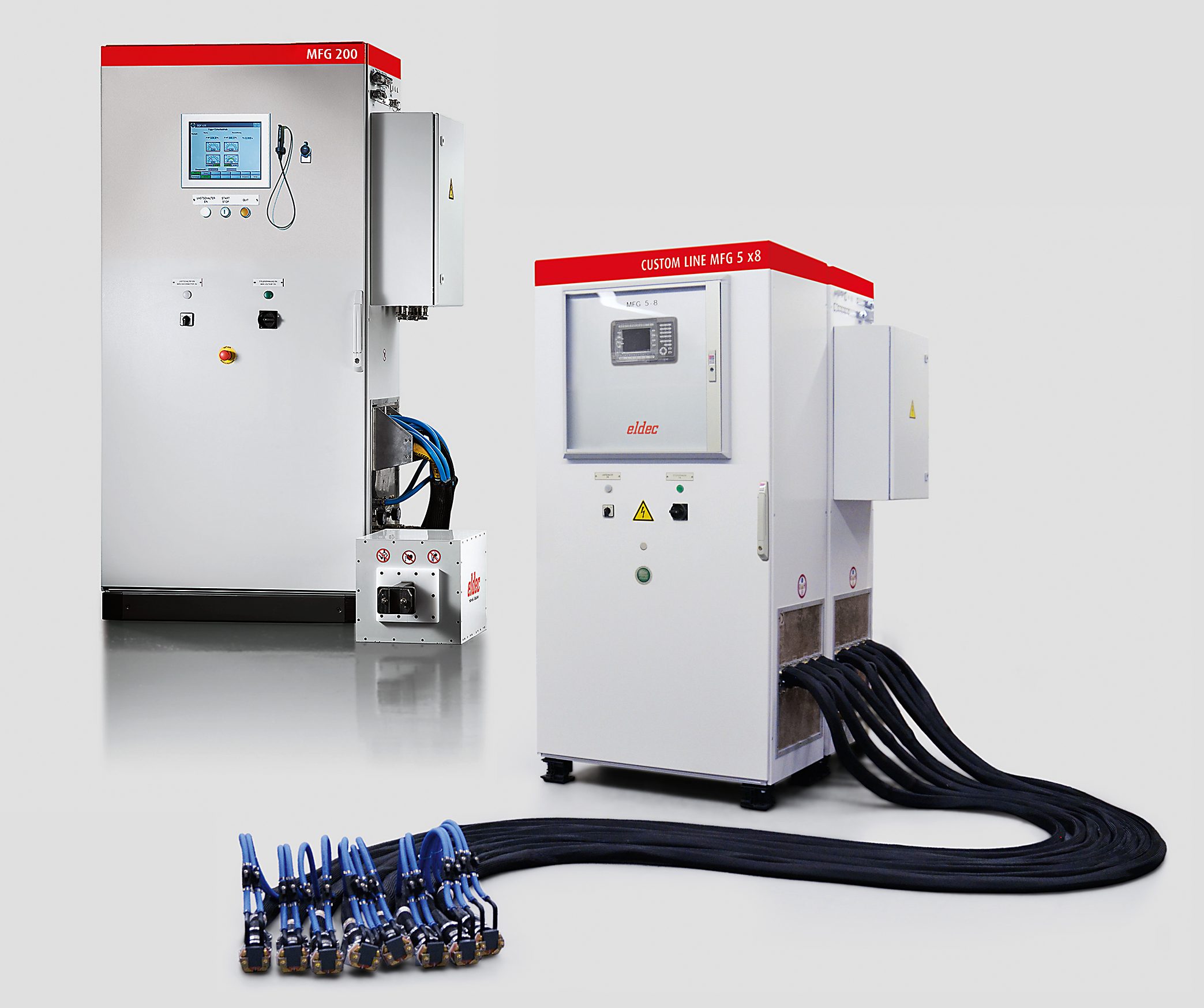
“Customized” is the key word when it comes to delivering a perfect production solution in plant and machinery manufacture. Each technology is to a large extent individually tailored to the customer’s environment, guaranteeing a highly efficient, optimally configured process.
Induction heating, especially, is one technology that must be “customized,” because the quality of the procedure depends on a range of specific details in the user’s application. The generator, being the energy source, plays an important role in this, as the experts at EMAG subsidiary eldec, based in Dornstetten, Germany, know well. They have been developing a variety of generators for more than 30 years, including many customized models in their CUSTOM LINE. Their approach is to engineer all the resonant-circuit components in conjunction with the control architecture to form a customized product, which provides induction heating with high efficiency, controlled application of energy, and stable processes. In order to make this process successful, close collaboration with the customer is required throughout the entire development process of the generator.
There are many possible application areas for induction hardening technologies. This efficient technique is used in the manufacture of plant and machinery, in the automotive sector, in aerospace, and in tool-and-die making. In the latter case, it is used to harden precisely those features of the tool or die that carry the greatest load later in the punching or embossing machine. Another typical area of application is the heating of components for a subsequent joining process. The technology is also used in standardized applications such as induction brazing and soldering, especially in the energy sector. Its decisive advantage here is precise targeting: The electromagnetic field applied can be adjusted perfectly to the workpiece in terms of its frequency, output, and field characteristics, so only a very precisely defined area is actually heated. This precise application of energy also ensures speed, minimal workpiece distortion, and economical energy consumption.
In many respects, however, the result depends on the technology used. Apart from the inductor, it is the generator that attracts the special attention of the developers. The induction specialists at eldec therefore offer customers not only the standardized models of the PICO, MICO, and ECO series, but also the tailored products of the CUSTOM LINE. Harry Krötz, head of electrical engineering R&D at eldec, said, “We always adjust the resonant circuit, the inverter, and the inverter control to match the inductor, the required frequency, and the output. We do that even with our more standardized series, with which we can currently cover about 80 percent of applications. With our CUSTOM LINE, however, virtually all the components can be configured in a fully variable way — from general device control to the outputs and interfaces.”
Just how far this approach goes can be seen by taking a look at the details of the configuration, such as the outputs, for example. The eldec engineers are not only able to equip their technology with single or multiple outputs, but also to distribute the output of the generator however they wish. For example, it can be made available in parallel for independent control, or it can be supplied in an “either-or” arrangement so it is only ever available at one of the outputs at a time. What are the advantages of multiple outputs for the user?
“That depends on the heating task,” Krötz said. “For example, you could use them to heat several locations on the part at the same time, speeding up the cycle time. You could also connect a variety of inductors to just one generator and operate them one after the other. This would allow you to reduce your purchasing costs for heating equipment if the cycle time was of secondary importance.”
At the same time, eldec is always able to modify the power and frequency features of its devices in virtually unlimited ways to adapt the process to the customer’s needs. The scope ranges from medium-frequency generators with 20 to 1,500 kW power output and a frequency range from 8 to 40 kHz up to high-frequency generators with 20 to 1,500 kW output and frequency ranges from 80 to 400 kHz. A multitude of combinations are possible. It is ultimately the part or the contours that need to be heated that determine the final design. This may even entail values greater than or less than the values quoted above.
“More and more often customers are asking for HF generators with very low frequencies, even below the 80 kHz mark,” Krötz said. “Typically, we can even satisfy those requests. eldec also offers customized generators for outputs below 20 kW. For instance, we have built an MFG 5 with eight outputs several times for one customer. In fact, every second CUSTOM LINE generator constitutes a new system, one we have never before put together in that particular way before. We have a lot of experience now in expanding our technology toolkit.” The same also applies to the “adjustment range,” which refers to the ratio of the smallest inductor to the largest, or the range of frequencies which can be operated with a single generator.
To ensure the quality and stability of the technology, eldec uses a high degree of vertical integration, more than 90 percent. All the central components are designed in Dornstetten and assembled by hand. In addition, the whole sequence, from first customer contact to delivery of the product, is clearly defined.
All in all, eldec believes that its highly customizable generator range puts it in an ideal position in the marketplace.
“We have at our disposal a huge pool of knowledge gained from practical experience, we are continuously improving the technology, and we only supply components that are optimally configured and robust,” Krötz said. “On top of that, our high level of vertical integration gives us the advantage of quick reaction times and high flexibility. That is a sought-after quality, especially for heating applications, which are often very specialized.”
More info www.emag.com
























